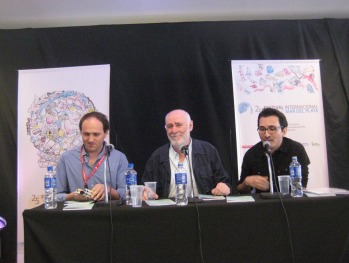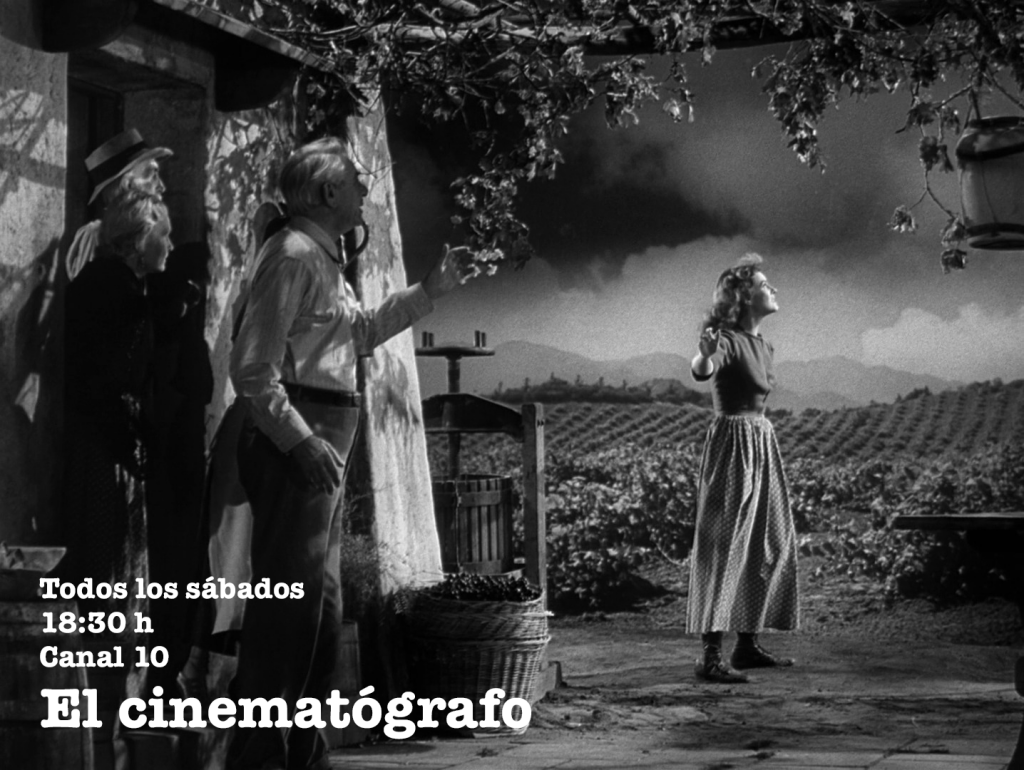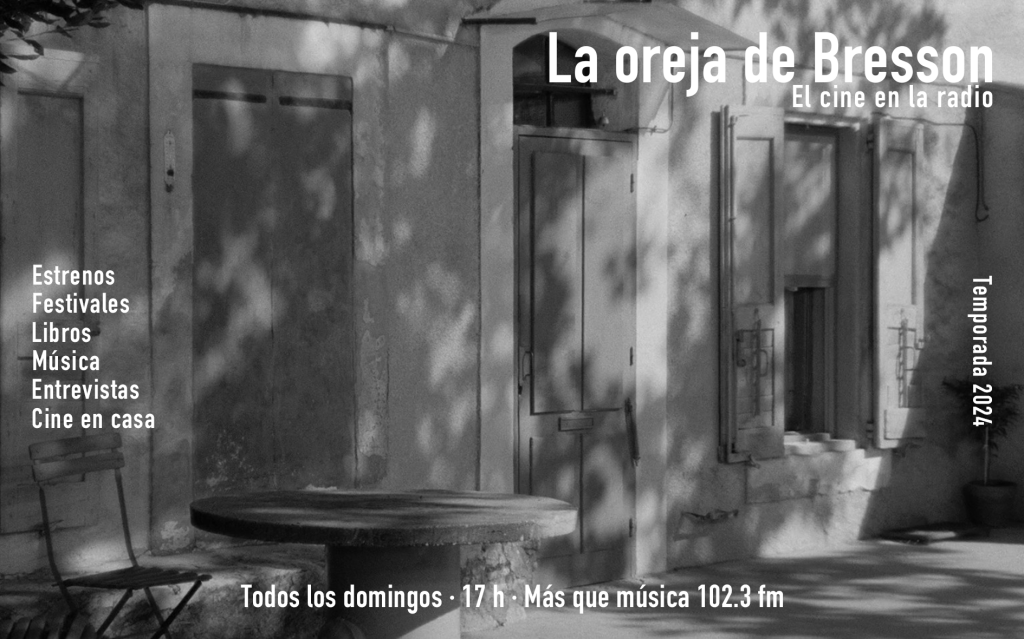
MDP (01) DESPUÉS DEL LIMBO
Two years later: today’s cinema: a dialogue with Quintín

Por Roger Alan Koza
Finalmente, el libro Cine del mañana existe, cuya edición estuvo a mi cargo, se publicó, se presentó (la foto lo demuestra) y veremos si se vende. Me parece que quedó bien. No pudo ser bilingüe, aunque quizás la versión en inglés se suba a la web del festival de Mar del Plata y se pueda bajar en PDF. A continuación dejo la versión en inglés del diálogo con Quintín que cierra el libro. (Roger Koza)
***
Roger Koza: Two years have passed since a group of critics of different nationalities and generations sought to think out the future of cinema. This event called “Cinema of Tomorrow”, took place within the framework of the twenty-second Mar del Plata International Film Festival. To speak about the future of cinema may sound abstract also utopian and discouraging, however all participants insisted on distancing themselves from generalizations and on being specific. It was about understanding a number of situations that would shape the way we understand cinema, where we watch it, how we interpret it and what lines of discussions revolve around it. How do you see Mar del Plata conferences today in the light of time gone by?
Quintín: I don’t think much has changed over the last two years as far as the general situation of cinema is concerned, particularly that which was tackled in the conferences, which dealt more with the present than with an abstract future. “Cinema of Tomorrow” was a somewhat pretentious title, a marketing strategy, if you will. The real intention behind these conferences was to make a diagnosis of what was going on with an eye on certain contemporary tendencies. Nobody showed up with a crystal ball; on the contrary, we intended to present very concrete subjects, tangible I would say; and even if these concerns were available to the common spectator, to try and distance them from the arts & entertainment sections and the way the press deals with cinema. In any case, it was about looking from a distance and providing food for thought; a pause in information technology onward rush and even in the dynamics of festivals, so focused on the new.
RK: Somehow, it seemed to me that these conferences were a follow-up to the Movie Mutations project, those epistolary exchanges between critics from several latitudes who had been initially brought together by Jonathan Rosenbaum. Those exchanges were first published in Trafic in 1997 and later expanded in 2001 within the framework of the BAFICI, where you worked as a new catalyst and master of ceremonies. This ended up as a book in Spanish (Cartas de cine, 2002) and its later definitive English version (Movie Mutations, 2003), which included the two collections of letters and additional essays written by other mutants. The purpose has always been the same: to analyze the transformations of cinephilia, which was also a way to think out criticism and therefore to map out the new tendencies of contemporary cinema. I had the impression that “Cinema of Tomorrow” was another chapter in that project; Rosenbaum and Peranson were there, and they had been, along with you, the main participants of Movie Mutations.
Q: The original project of Movie Mutations, the letters published in Trafic in 1997 which later had different spin-offs and follow-ups (among them, a second collection of letters that we published at the BAFICI), was very important for several reasons. To begin with, it meant the first cosmopolitan discussion among critics, a key detail that tends to be overlooked. Critics gathered, and still do, in national ghettos; and even though everybody keeps repeating that the language of cinema is universal, when I started travelling I found out that it was almost impossible for a Cahiers critic to really communicate with one from El Amante, or for Spanish and Italian critics to even pay attention to what was being said outside their own borders, while Americans were stuck on what was going on in Hollywood and nobody seemed to have ever spoken in public to an Asian, African or Australian critic. Being able to notice that lack – so evident and yet so overlooked- and attempting to correct it was Rosenbaum’s great achievement (we should add that communications have improved ever since). The letters in Movie Mutations intended to tear down national borders as well as bridge the generation gap, to bring together critics of different ages on the basis of each ones cinephile genealogy. Sometimes, when it comes to determining likings and allegiances, that difference is crucial. I think this is increasingly the case and I believe that shortening distances between critics is becoming more and more difficult. Rosenbaum’s project was visionary in that sense too, by noticing that certain personal affinities and rejections (but often generational rejections) regarding the different chapters in the history of cinema, should be clearly stated beforehand in order to smooth the process of a productive dialogue. The Mar del Plata conferences were intended to bring together the experience of Movie Mutations but perhaps in a different way: calling upon the plural and international expression of critics, giving them a space they do not usually have in festivals where the ones who generally express themselves -not only through their work but in interviews, master classes and presentations- are the filmmakers; while producers, sales agents, etc.. also participate with their market decisions. However, experience shows that only critics have an independent view of cinema, unbiased by interests, even if those interests were a legitimate defense of the work itself. Directors, producers, salespersons, even programmers (there are exceptions, of course) have a biased view of the movie world. To have critics in Mar del Plata also aimed at giving them the space they are generally denied. That was something we always tried to do at the BAFICI: to break out of the idea that to invite critics to a festival is only good enough for “working the press”. I have always thought that giving critics a space, even one of privilege, provides a significant contribution to the quality of a festival.
RK: In the 2008 Atlas of the Cahiers du Cinéma, there is a dossier on festivals. Jean-Michel Frodon, current director of the Cahiers, says that festivals are the alter-ego of critics. What are festivals good for? What is the existing relation between festivals and critics? What does it mean to be a programmer? What is the role of an artistic director? And finally, what mutations are film festivals undergoing, that there are more and more of them and that they constitute a phenomenon that calls for clarification
Q: One of the latest unquestionable changes in the movie business is the one related to film distribution. Today, all around the world they only show the movies produced or sold by Hollywood studios or those produced in the country. Only American films get to be presented in premier movie theaters. Technology somehow compensate for this bias thanks to the DVD, the television and, above all, to the (legal or illegal) downloading of films off the Internet. Auteur films, art cinema, or simply the cinema that is not made or distributed by Hollywood, has ended up having, so to speak, a purely virtual medium, with the exception of film festivals, true non-virtual strongholds of resistance against Hollywood hegemony. Festivals are the only physical seat of alternative cinema (film libraries, film clubs, etc… reach out to a far smaller audience); it is the only place where the rest of the cinema can still reach a mass audience -even in its own scale- that generates a second movie market. Suffice it to say that there are fewer films premiered in Argentina in a year than in Mar del Plata and Buenos Aires film festivals combined. In addition, festivals are a meeting place for the world of cinema providing the opportunity to relate at a personal level, something that cannot be fully replaced by virtual reality. In the world of cinema, human contact is given by festivals and that contact, which includes the participation of spectators, is the driver of change and infuses energy into the movie-making business. Since they provide for such basic needs (an alternative to a mainstream program and human presence), festivals have noticeably proliferated. To program a festival, to choose what you want to show, is a way of practising criticism by other means. However, it requires a certain awareness of the purpose of that role. I cannot conceive of a programmer who is not critical and who, on the contrary, merely chooses a few films according to his/her own taste, which could be as good as the next person’s. To program is to intervene in culture and this calls for intellectual grounds, as opposed to the concept of the programmer as a wage-earning chooser. An artistic director, just like a museum curator or a theater director, is someone who has to suggest an editorial line and a conception of cinema and also to provide the festival with an organic structure that is capable of answering to that conception and of going beyond a mere accumulation of remarkable movies of the year. Otherwise, the task is impoverished, causing festivals to resemble each other and encouraging the circulation of the same films everywhere, contributing to the tendency of many programmers to follow the dominant opinion, which in turn has brought about the stagnation and the standardization of the so-called “independent” cinema which in fact is becoming more and more formatted and predictable as a response to the parameters set by a handful of European production companies.
RK: Cristina Nord’s conference suggested a certain stagnation of New Argentine Cinema; her analysis was based on a vaguely similar phenomenon that befell the development of the so-called New German Cinema. She argued that the world no longer showed the same interest in Argentine cinema for it was known to have passed its prime. Her diagnosis seemed to be valid but then came the future with some possible objections: Liverpool, by Lisandro Alonso, Leonera, by Pablo Trapero, Historia extraordinarias, by Mariano Llinás, Copacabana, by Martín Rejtman, just to mention a few. What should be said about New Argentine Cinema today? Do you see a somewhat analogous situation in other similar cinemas, such as in that of Mexico or Brazil? Do these films need the existence of festivals?
Q: A certain artistic stagnation and loss of initial freshness in new directors, a sort of vulgarization in recent years has affected Argentine cinema. And yet, some years are better than others and 2008 in particular does not seem to be one of the worst. Argentina has consolidated a production model that is based on getting a subsidy from INCAA and doubling and tripling it with the support of international co-producers, only to make movies that are much more expensive than they should have been, with the additional problems of creative laziness and aesthetic customization to fit the parameters this mechanism has set. The result is a paradox: movies are made for the festival circuit; however since these films are very much like one another, those same festivals end up rejecting them. In any case, Argentina is far better off than the rest of Latin America, where the standardization of products, a copycat tendency and manipulation for commercial purposes is even more noticeable. Unfortunately, the region produces a majority of films that are bound to remain within national borders or to become indistinguishable from the rest of the production made for international consumption.
RK: Burdeau’s exceptional lecture emphasized the general digitalization of the way in which we experience the world; in his view, Abbas Kiarostami’s The Wind will Carry Us and, The World by Zhang-ke Jia, were good examples of this. Later Rosenbaum knowingly analyzed the changes in film discourse in the digital era and finally the optimist Arroba defended the almost infinite access –a sort of radical democratization via Internet-, to all the cinema we are unable to see if we confine ourselves to the market logic and to distribution decisions. How do you see these mutations affecting distribution, the role of festivals, film criticism, production systems and modes of reception?
Q: Broadly speaking, one could say that there is an important aesthetic change with digital shooting, editing and viewing. The latter promises the utopia of democratization suggested in Arroba’s conference which will put the whole history of cinema just a click away. In any case, this already existing (though somewhat troublesome) increased supply is not accompanied by a qualitative progress in film culture that could parallel the boom of technical wisdom. We still do not fully grasp that making a movie now means making it available to an overwhelming majority world-wide, whereas in the past it used to be the property of a chosen few. At the same time, any film school graduate knows his business better than the average veteran of the previous generation. In addition, theoretical and academic studies on all aspects of cinema have dramatically proliferated. And yet that proliferation of knowledge does not translate itself into a richer, more rigorous and lucid understanding of the art of cinema.
I dare say you can rarely find a film director who knows the ropes and who is also technically knowledgeable, with a general understanding of his craft and a clear sense of his own aesthetic, professional and existential development. Filmmakers are filled with doubts about their path and their own worth, about the decisions that will lead them to develop a meaningful career. That is why criticism, understood as a dialogue with the artists, is becoming increasingly important at this moment of uncertainty. Of course, this uncertainty is shared by the critics themselves…
RK: Finally, I would like to ask you a question that is as simple as it is sharp, as bastardized as it is necessary: what is cinema? Bazin posed this question and answered it at a specific historical moment. In other words: what is cinema today, in this present time where anyone can shoot and the audiovisual is the matrix of our general knowledge?
Q: It is very impressive to think that André Bazin, who died in 1958, was perhaps the last thinker to have elaborated an enlightening and deep conception of cinema; a conception which, above all, was capable of influencing the manner in which cinema is made and of providing a framework to discuss the question, even against his own ideas. Maybe Godard is right and that type cinema, that is, that aesthetic, political, ideological and vital outburst that shook the world for fifty years, that discipline that arose from the most ordinary empiricism and grew more sophisticated at an amazing rate, has probably come to an end. In other words, though in its death throes, the cinema of Griffith, Renoir, Ford, Ozu, Rossellini, Straub and Hong Sang-soo is probably over as such. And so the question “What is cinema?” should turn into “What was cinema?” and the answer is very clearly and beautifully put in the Histoire(s) du cinéma.
Or maybe Burdeau, one of our guests, is right when he announces that the digital era has put an end to the age of shots and has finally substituted it for the age of image. It is a very broad concept and in this view cinema becomes a concept in the making. Only then would there be a “cinema of tomorrow” willing to include television, video art and clip, animated design, American series and amateur movies from Saladillo. To think out cinema today is not clearly simpler or more productive than in Bazin’s times. But maybe it is necessary. Time will tell.
Foto: gentileza de La lectora provisoria (Izq: RK; centro: Quintín; derecha: el gran Marcelo Alderete).





No pude decírtelo en persona: me gustó la claridad y modestia de tu exposición. Ya leí el libro y está muy bueno. Felicitaciones.
Gracias Fer, y por tomarte, especialmente, el tiempo para leer y luego escribir. RK